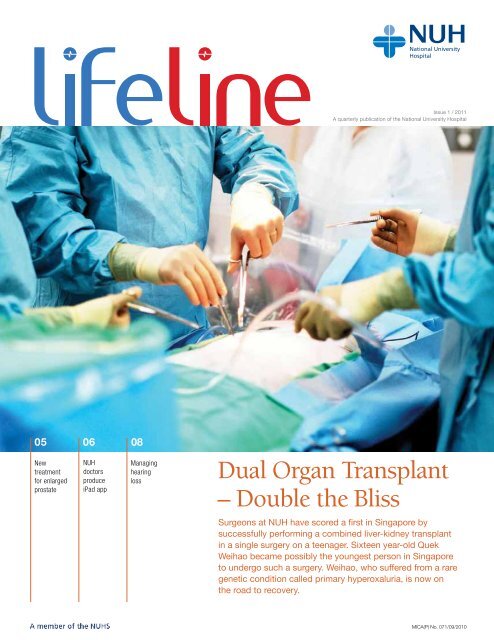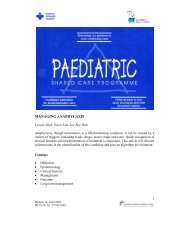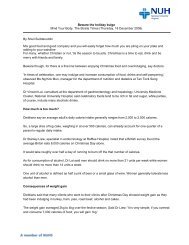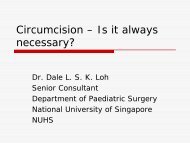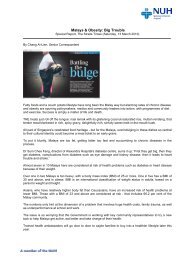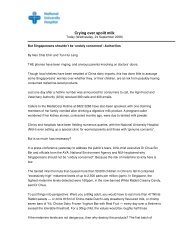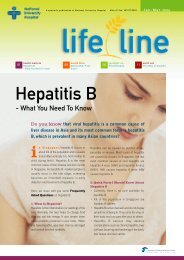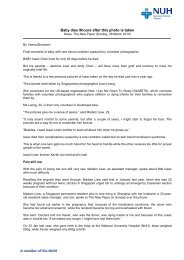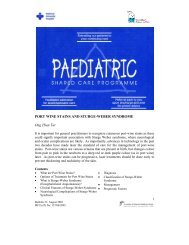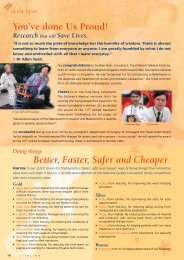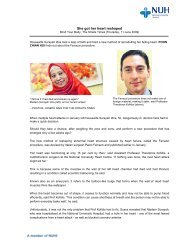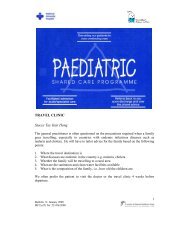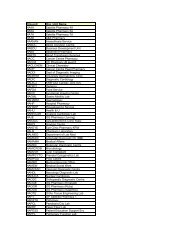Dual Organ Transplant – Double the Bliss - NUH
Dual Organ Transplant – Double the Bliss - NUH
Dual Organ Transplant – Double the Bliss - NUH
You also want an ePaper? Increase the reach of your titles
YUMPU automatically turns print PDFs into web optimized ePapers that Google loves.
Issue 1 / 2011<br />
A quarterly publication of <strong>the</strong> National University Hospital<br />
05 06 08<br />
New<br />
treatment<br />
for enlarged<br />
prostate<br />
<strong>NUH</strong><br />
doctors<br />
produce<br />
iPad app<br />
Managing<br />
hearing<br />
loss<br />
<strong>Dual</strong> <strong>Organ</strong> <strong>Transplant</strong><br />
<strong>–</strong> <strong>Double</strong> <strong>the</strong> <strong>Bliss</strong><br />
Surgeons at <strong>NUH</strong> have scored a first in Singapore by<br />
successfully performing a combined liver-kidney transplant<br />
in a single surgery on a teenager. Sixteen year-old Quek<br />
Weihao became possibly <strong>the</strong> youngest person in Singapore<br />
to undergo such a surgery. Weihao, who suffered from a rare<br />
genetic condition called primary hyperoxaluria, is now on<br />
<strong>the</strong> road to recovery.<br />
MICA(P) No. 071/09/2010
cover story<br />
02<br />
On 3 November 2010 at 4am,<br />
which was about <strong>the</strong> same<br />
time <strong>the</strong> alarm went off to wake<br />
Weihao for his kidney dialysis, he received<br />
a call that would change <strong>the</strong> course of his<br />
life. His long wait was over - a suitable liver<br />
and kidney had been found.<br />
Weihao suffered from primary<br />
hyperoxaluria <strong>–</strong> a rare genetic disorder<br />
which led him to form kidney stones at <strong>the</strong><br />
tender age of five.<br />
Sometime in 2009, Weihao’s fa<strong>the</strong>r noticed<br />
that something was not right with his only<br />
son as he was losing weight. Weihao<br />
also got tired very easily. His kidney was<br />
starting to fail.<br />
Weihao started dialysis - which took him<br />
around 10 hours everyday - when his<br />
kidney failure became more acute.<br />
‘His weight dropped drastically from<br />
68kg to 58kg in a matter of weeks. He<br />
was about 50kg when he went in for <strong>the</strong><br />
operation,’ said his mo<strong>the</strong>r.<br />
On that fateful night, Professor K<br />
Prabhakaran, Director, Paediatric <strong>Organ</strong><br />
<strong>Transplant</strong> Programme at <strong>NUH</strong> was<br />
awoken from his sleep by a call at 2am,<br />
informing him that <strong>the</strong>re was a suitable<br />
liver for Weihao. At <strong>the</strong> same time,<br />
Weihao’s primary physician Prof Yap<br />
Hui Kim contacted him to discuss <strong>the</strong><br />
possibility of a simultaneous liver and<br />
kidney transplant.<br />
When both organs were found to be<br />
suitable, <strong>the</strong>y called to inform <strong>the</strong> family<br />
at 4am. Weihao was admitted at 7am to<br />
prepare for <strong>the</strong> surgery.<br />
The multi-disciplinary team led by<br />
Professor Prabhakaran started with <strong>the</strong><br />
liver transplant operation which took<br />
eight hours. Professor Prabhakaran<br />
and Dr Tiong Ho Yee, Consultant,<br />
Department of Urology, <strong>NUH</strong> <strong>the</strong>n<br />
moved on to <strong>the</strong> kidney transplant<br />
which took ano<strong>the</strong>r three hours.<br />
Weihao received a new kidney and<br />
liver in slightly over 24 hours.<br />
The surgery scored a first in <strong>the</strong><br />
medical history in Singapore, making<br />
it to a selected list of success stories in <strong>the</strong><br />
world. A 2006 American report stated that<br />
to date, only 1,032 combined liver-kidney<br />
transplants (inclusive of adults) had been<br />
performed worldwide.<br />
Now Weihao is able to do<br />
<strong>the</strong> one thing he has always<br />
dreamed of - to travel<br />
<strong>the</strong> world.<br />
Mdm Lim Kim Hiok,<br />
Weihao’s mo<strong>the</strong>r.<br />
What Weihao had - Primary Hyperoxaluria<br />
A person suffering from this condition will have too much<br />
of a substance called oxalate, or salt crystals present in<br />
<strong>the</strong> urine. It is a natural by-product of metabolism but too<br />
much of it causes kidney stones. The stones can cause<br />
urinary obstruction, secondary infection of urinary tract and<br />
eventually kidney damage. It becomes progressively more<br />
severe, and can lead to death.<br />
In Type 1 primary hyperoxaluria, which is <strong>the</strong> genetic<br />
disease that Weihao is suffered from, <strong>the</strong> liver creates<br />
too little of an enzyme called alanine/glyoxylate<br />
aminotransferase (AGT).<br />
Very large amounts of oxalate are produced when <strong>the</strong>re is<br />
not enough of this enzyme in <strong>the</strong> liver.<br />
Among patients with primary hyperoxaluria, half will have<br />
kidney failure by age 15, and about 80 per cent will have<br />
kidney failure by age 30. For that reason, it is critical to<br />
have primary hyperoxaluria diagnosed and treated as early<br />
as possible.<br />
Patients most often develop <strong>the</strong> first symptoms, typically<br />
kidney stones, anywhere from birth to <strong>the</strong> mid-20s.<br />
However, <strong>the</strong> condition may go undiagnosed until age 30<br />
to 40. In some patients <strong>the</strong> first symptom is kidney failure.<br />
Patients with Type 1 primary hyperoxaluria who do not<br />
sufficiently respond to Vitamin B6 will need a liver and<br />
kidney transplant to cure <strong>the</strong>ir disease.
<strong>Dual</strong><br />
<strong>Transplant</strong><br />
The team behind Weihao’s successful<br />
surgery:<br />
Department of Paediatric Surgery, University<br />
Children’s Medical Institute<br />
Professor K Prabhakaran (Head & Senior<br />
Consultant) (Director, Paediatric <strong>Organ</strong><br />
<strong>Transplant</strong> Programme)<br />
Dr Dale Loh (Senior Consultant)<br />
Dr Mohamed Abubacker Ahamed Faiz Ali<br />
(Registrar)<br />
cover story<br />
03<br />
Division of Hepatobiliary & Pancreatic<br />
Surgery, University Surgical Cluster<br />
Associate Professor KK Madhavan (Head &<br />
Senior Consultant)<br />
Dr Iyer Shridhar Ganpathi (Consultant)<br />
Dr Victor Lee (Consultant)<br />
Department of Hand & Reconstructive<br />
Microsurgery<br />
Dr David Tan (Consultant)<br />
Department of Urology, University Surgical<br />
Cluster<br />
Dr Tiong Ho Yee (Consultant)<br />
Department of Anaes<strong>the</strong>sia<br />
Dr Wong Weng Hoa (Senior Consultant)<br />
Division of Paediatric Nephrology, Dialysis &<br />
Renal <strong>Transplant</strong>ation, University Children’s<br />
Medical Institute<br />
Professor Yap Hui Kim (Head & Senior<br />
Consultant)<br />
Dr Perry Lau (Consultant)<br />
Division of Paediatric Gastroenterology,<br />
Hepatology & Liver <strong>Transplant</strong>ation,<br />
University Children’s Medical Institute<br />
Professor Quak Seng Hock (Head & Senior<br />
Consultant)<br />
Associate Professor Marion Aw (Senior<br />
Consultant)<br />
Source:<br />
The Straits Times @ Singapore Press Holdings Ltd.<br />
Reprinted with permission.<br />
Liver & Kidney <strong>Transplant</strong> Office<br />
Ms Priscilla Wee (<strong>Transplant</strong> Coordinator <strong>–</strong> Liver)<br />
Ms Hamidah Bte Mistam (<strong>Transplant</strong> Coordinator<br />
<strong>–</strong> Liver)<br />
Ms Manjit Kaur (Senior Manager, Clinical<br />
<strong>Transplant</strong> <strong>–</strong> Kidney)
<strong>NUH</strong> news bites<br />
04<br />
<strong>NUH</strong>S Residency Programme Receives<br />
ACGME-I Accreditation<br />
The National University Health<br />
System (<strong>NUH</strong>S) Residency<br />
Programme is now one of <strong>the</strong><br />
few outside <strong>the</strong> US to be accredited by<br />
<strong>the</strong> Accreditation Council of Graduate<br />
Medical Education-International<br />
(ACGME-I), a non-governmental<br />
organisation responsible for <strong>the</strong><br />
accreditation of international Graduate<br />
Medical Education (GME) programmes.<br />
The six specialist training programmes<br />
that have been accredited include<br />
Emergency Medicine, Internal Medicine,<br />
Paediatrics, Pathology (Preventive<br />
Medicine and Transitional Year). The<br />
accreditation is testimony that <strong>the</strong>se<br />
programmes have been assessed to<br />
provide high quality training which is<br />
comparable with <strong>the</strong> standards set for<br />
<strong>the</strong> US.<br />
The <strong>NUH</strong>S postgraduate training<br />
programme for doctors moved from<br />
UK-based training to <strong>the</strong> US-styled<br />
ACGME-I in May 2010. Under <strong>the</strong><br />
ACGME-I structure, trainee doctors (or<br />
residents) undergo structured specialist<br />
training conducted by dedicated senior<br />
clinicians after graduating from medical<br />
school. They are regularly assessed on<br />
<strong>the</strong>ir medical knowledge, patient care<br />
skills, professionalism, interpersonal and<br />
communication skills. This ensures <strong>the</strong><br />
aspiring specialists are well-trained and<br />
equipped with <strong>the</strong> necessary skills and<br />
knowledge before <strong>the</strong>y see <strong>the</strong>ir first<br />
patients.<br />
One of <strong>the</strong> key strengths of <strong>the</strong> ACGME programme is that of structured training -<br />
what needs to be taught in <strong>the</strong> curriculum is not left to chance but it will be planned to be<br />
covered.<br />
A director and core faculty with dedicated time for teaching and curriculum development<br />
are specially appointed for each programme. The very structured program evaluation with<br />
<strong>the</strong> sponsoring institutions having ‘ownership’ of <strong>the</strong> residents, will hopefully improve <strong>the</strong><br />
standard of training and teaching among <strong>the</strong> residents.<br />
With <strong>the</strong> programme, <strong>the</strong> residents will be able to receive timely feedback and remediation<br />
ra<strong>the</strong>r than wait till <strong>the</strong> intermediate/final exams to know <strong>the</strong>ir gaps in knowledge.<br />
Associate Professor Shirley Ooi, Designated Institutional Official,<br />
<strong>NUH</strong>S Residency Programme<br />
Residents like myself now undergo a structured education programme that is wellsupervised.<br />
We now have designated protected time for teaching and regular sessions<br />
with our Programme Directors on our learning and performance. This represents a major<br />
change from <strong>the</strong> existing system where learning is largely opportunistic and mostly takes<br />
place in our free time.<br />
Dr Ng Chew Lip, <strong>NUH</strong>S Resident<br />
The <strong>NUH</strong>S Residency Programme is<br />
one of <strong>the</strong> three postgraduate medical<br />
training programmes in Singapore.<br />
Thirty specialists from <strong>the</strong> first batch are<br />
expected to graduate in 2013, adding to<br />
<strong>the</strong> 907-strong clinical staff at <strong>NUH</strong>.<br />
Irregular meals, Helicobacter pylori infection and gastritis<br />
According to a recent study conducted by <strong>the</strong> Dietetics Department at<br />
<strong>the</strong> <strong>NUH</strong>, people who eat irregular meals too often are likely to raise <strong>the</strong>ir<br />
risks of getting Helicobacter pylori (HP) infection, which may in turn up<br />
<strong>the</strong>ir risks of gastric cancer.<br />
Helicobacter pylori (HP) is a type of bacteria that can penetrate and infect <strong>the</strong><br />
protective layer of <strong>the</strong> stomach lining, causing <strong>the</strong> individual to develop gastritis<br />
or an inflamed stomach lining.<br />
“We found that people who frequently ate earlier or later than <strong>the</strong>ir usual meal<br />
timings and over a prolonged period were associated with a significantly higher<br />
incidence of HP infection and gastritis,” said Ms Lim Su Lin, <strong>NUH</strong>’s chief dietician<br />
who led <strong>the</strong> study.<br />
Results showed that compared with individuals who had regular eating patterns,<br />
those who deviated from <strong>the</strong>ir meal times by exactly or more than two hours at least<br />
twice a week were six times more at risk of developing HP <strong>–</strong> a condition estimated<br />
to affect 30 per cent of Singaporeans. People infected with HP are at increased risk<br />
of gastric cancer in <strong>the</strong> long run.<br />
The study won <strong>the</strong> Singapore Allied Health Award at <strong>the</strong> inaugural Singapore<br />
Health and Biomedical Congress jointly organised by <strong>the</strong> National University<br />
Health System and National Healthcare Group late last year.<br />
Four fast tips on managing your diet<br />
while keeping up with a busy schedule<br />
1. Fix your meal times and keep to that<br />
schedule as much as you can.<br />
2. Keep some snacks at hand in case you<br />
are held up at work or long meetings.<br />
Consider healthy snack bars, fruits or<br />
dried fruits, nuts or biscuits.<br />
3. Whatever little you can have is better<br />
than nothing. Don’t fix your meetings or<br />
appointments during lunch time if you can<br />
help it. O<strong>the</strong>rwise, try to bring along your<br />
lunch or check if lunch is provided.<br />
4. Have a quick bite before meetings if <strong>the</strong>y<br />
are likely to stretch beyond your usual<br />
lunch time.
New treatment for enlarged prostate<br />
Men with prostate enlargement<br />
or Benign Prostate Hypertrophy<br />
(BPH) can now be treated in<br />
<strong>the</strong> clinic using a new minimally invasive<br />
procedure called Transurethral Needle<br />
Ablation of Prostate Gland (TUNA). The<br />
procedure offers faster recovery, enabling<br />
patients to return to <strong>the</strong>ir normal day-today<br />
activities within a week.<br />
on medication experience significant<br />
voiding improvements. Medication is also<br />
expensive and comes with side effects.<br />
“This new procedure offers patients with<br />
BPH a minimally invasive treatment option.<br />
It bridges <strong>the</strong> gap between medication<br />
and surgery,” says Dr Chua Wei Jin,<br />
Consultant, Department of Urology, <strong>NUH</strong>.<br />
difficult to control my urine for almost one<br />
year. After <strong>the</strong> surgery, I was able to return<br />
to my normal activities within one week.<br />
Now, I can travel without having to rush<br />
to <strong>the</strong> toilet at every stop and I can sleep<br />
undisturbed through <strong>the</strong> night,” says Mr<br />
Tony Tan, 73.<br />
<strong>NUH</strong> news bites<br />
05<br />
<strong>NUH</strong> is <strong>the</strong> first hospital in Sou<strong>the</strong>ast Asia<br />
to offer such a procedure in an outpatient<br />
setting.<br />
Doctors estimate that BPH affects 40<br />
per cent of men aged 60 and above,<br />
both globally and locally. Though noncancerous,<br />
<strong>the</strong> condition affects <strong>the</strong><br />
quality of life of both <strong>the</strong> men and <strong>the</strong>ir<br />
spouses, with interrupted sleep at night<br />
and disruptions to daily routines due to <strong>the</strong><br />
frequent need to visit <strong>the</strong> toilet.<br />
Traditionally, surgery and oral medication<br />
have been used to treat BPH and its<br />
symptoms. However not all patients<br />
“TUNA is currently offered at <strong>the</strong> clinic<br />
and <strong>the</strong> procedure takes on average 30<br />
minutes. It is done under local anes<strong>the</strong>sia<br />
and <strong>the</strong> patient is able to return home on<br />
<strong>the</strong> same day.”<br />
TUNA has been used increasingly in <strong>the</strong><br />
United States and it has shown to be safe<br />
and effective in relieving <strong>the</strong> symptoms<br />
of BPH. So far, more than 30 patients<br />
have been successfully treated since <strong>the</strong><br />
procedure became available in <strong>NUH</strong> last<br />
year.<br />
“I was advised by <strong>the</strong> doctor to consider<br />
TUNA because I was finding it increasingly<br />
Using radiofrequency waves, two needles are inserted into <strong>the</strong> prostate.<br />
The heat generated from <strong>the</strong> needles causes <strong>the</strong> prostate gland<br />
to shrink. The procedure takes about 30 minutes, and patients are<br />
discharged within hours with a urinary ca<strong>the</strong>ter that can be removed<br />
from <strong>the</strong> bladder after three to five days.<br />
Photo: Medtronic, Inc. 2008<br />
Symptoms of BPH<br />
- Difficulty in starting urination (hesitancy)<br />
- A weak urinary stream<br />
- Interruption of <strong>the</strong> stream (‘stopping’<br />
and ‘starting’ effect)<br />
- Sensation of incomplete bladder<br />
emptying<br />
- Urgency (<strong>the</strong> person has difficulty in<br />
holding <strong>the</strong> bladder)<br />
- Frequent urination<br />
- Waking up frequently at night to<br />
urinate (Nocturia)<br />
Who should consider going for<br />
TUNA?<br />
Patients with mild or moderate<br />
bladder obstructive symptoms<br />
who:<br />
- Are not able to tolerate <strong>the</strong> side<br />
effects of medication (which can<br />
include giddiness, lethargy and<br />
transient drop in blood pressure<br />
- Do not wish to continue with<br />
long term medical <strong>the</strong>rapy<br />
because of cost considerations<br />
Contact Us<br />
Location<br />
Operating<br />
Hours<br />
Appointments<br />
Urology Centre<br />
Kent Ridge Wing Level 9<br />
Monday to Friday<br />
8.30am <strong>–</strong> 6.30pm<br />
Tel: (65) 6772 2002<br />
Email: ent@nuhs.edu.sg<br />
Enquiries Tel: (65) 6772 5087<br />
Email: urology_centre@nuhs.edu.sg<br />
Web: www.nuh.com.sg/usc<br />
<strong>NUH</strong> Women’s Centre now open<br />
in <strong>the</strong> evenings<br />
To better serve our working patients and mo<strong>the</strong>rs-to-be, <strong>the</strong> <strong>NUH</strong><br />
Women’s Centre at <strong>the</strong> Kent Ridge Wing is now open in <strong>the</strong> evening from<br />
6.30pm to 8.30pm from Tuesday to Thursday.<br />
The <strong>NUH</strong> Women’s Centre provides treatment for a range of obstetric and<br />
gynaecological conditions including high-risk pregnancies, infertility and recurrent<br />
pregnancy loss.<br />
For appointments, please call 6772 2255 / 2277.
<strong>NUH</strong> news bites<br />
Link between low birth weight and metabolic<br />
diseases<br />
<strong>NUH</strong> researchers are looking into <strong>the</strong> link between low<br />
birth weight and obesity by studying <strong>the</strong> metabolic profile<br />
of overweight adults.<br />
06<br />
The three-year study, which is part two of <strong>the</strong> Singapore Adult<br />
Metabolism Study (SAMS), is led by Dr Eric Khoo (Consultant,<br />
Division of Endocrinology). It is funded by <strong>the</strong> National Research<br />
Foundation and administered by <strong>the</strong> National Medical Research<br />
Council. The Principal Investigators include Associate Professor<br />
Tai E Shyong (Head and Senior Consultant, Division of<br />
Endocrinology) and Associate Professor Lee Yung Seng (Senior<br />
Consultant, Division of Paediatric Endocrinology and Diabetes).<br />
On top of studying participants from birth in a related study -<br />
Growing up in Singapore Towards healthy Outcomes (GUSTO),<br />
<strong>the</strong> researchers are working backwards by recruiting healthy<br />
Chinese men aged 21 to 40 with a BMI of 23 to 30, and looking<br />
into <strong>the</strong>ir medical histories including birth weight. The ultimate<br />
aim of SAMS is to design strategies to reduce <strong>the</strong> burden of<br />
chronic diseases like diabetes and obesity.<br />
Participants first undergo a battery of tests to measure <strong>the</strong>ir<br />
energy expenditure and physical activity levels, fat distribution<br />
A SAMS participant having his metabolic readings recorded as part of <strong>the</strong> study.<br />
and how sensitive <strong>the</strong>y are to insulin. They <strong>the</strong>n go through a<br />
four-month weight loss programme, followed by post-intervention<br />
studies and follow-up visits over a year at three-monthly intervals.<br />
While <strong>the</strong> target is for participants to lose five to eight per cent of<br />
<strong>the</strong>ir weight, one has managed to shed 10 per cent of his original<br />
weight since he joined <strong>the</strong> study.<br />
The study started in September 2010 and it has since recruited<br />
24 participants. The team hopes to recruit 180 participants<br />
eventually. Interested individuals may wish to contact Mr Melvin<br />
Tan via 9061 7588 or email info@devos-sams.sg.<br />
<strong>NUH</strong> doctors produce iPad application on<br />
minimally invasive surgery<br />
Surgeons at <strong>the</strong> <strong>NUH</strong> have become <strong>the</strong> first in Singapore to develop a medical application<br />
on iTunes, <strong>the</strong> Apple online store.<br />
The information in <strong>the</strong> application is based on <strong>the</strong> second edition of <strong>the</strong> Manual of Endo-<br />
Laparoscopic and Single-Port Surgery by Associate Professor Davide Lomanto, Director of<br />
<strong>NUH</strong>’s Minimally Invasive Surgical Centre and Dr Cheah Wei Keat, Chairman Medical Board<br />
at Jurong Health Services and Visiting Consultant with <strong>NUH</strong>’s Department of Surgery. The<br />
manual is used in teaching medical students in Singapore and more than a dozen surgeons<br />
from <strong>NUH</strong> had contributed chapters to <strong>the</strong> book.<br />
On <strong>the</strong> iPad, a subscriber gets not only all <strong>the</strong> text information but also videos showing how<br />
procedures are done. The application also has a section on <strong>the</strong> equipment needed and how<br />
each one works.<br />
This Application is an interactive teaching tool that is<br />
accessible any time, anywhere. Medical students and resident<br />
trainees in surgery can surf up <strong>the</strong> Manual and know about<br />
indications and contraindications for every surgical procedure, <strong>the</strong><br />
kind of preoperative work up <strong>the</strong> patient requires before surgery,<br />
to <strong>the</strong> type of instrumentation and follow-ups required.<br />
A/Prof Davide Lomanto, Director, Minimally Invasive Surgical Centre, <strong>NUH</strong>
<strong>NUH</strong> upgrades to serve patients better<br />
Over <strong>the</strong> last year, patients and<br />
visitors to <strong>NUH</strong> will not miss <strong>the</strong><br />
massive ongoing redevelopment<br />
works happening in <strong>the</strong> hospital premises.<br />
For one, <strong>the</strong> Main Building facade is<br />
undergoing an overhaul. The new entrance<br />
facing Lower Kent Ridge Road is just steps<br />
from <strong>the</strong> exit of <strong>the</strong> soon-to-be-opened<br />
Circle Line Kent Ridge MRT Station. From<br />
here, patients and visitors will be able to find<br />
<strong>the</strong>ir way easily to <strong>the</strong> specialist outpatient<br />
clinics and wards using newly created<br />
walk ways. Come mid April, patients to<br />
<strong>the</strong> Dental Clinic and Centre for Hand<br />
and Reconstructive Microsurgery will be<br />
pleasantly greeted by a more comfortable<br />
and spacious waiting area.<br />
<strong>NUH</strong> news bites<br />
07<br />
The new wing will also be home to <strong>the</strong><br />
National University Heart Centre, Singapore,<br />
<strong>the</strong> second national centre on <strong>the</strong> <strong>NUH</strong><br />
campus for <strong>the</strong> management of cardiac<br />
conditions.<br />
The Main Building remodeling project, which<br />
started in September last year, is expected<br />
to be completed in phases by 2014.<br />
Artist’s impression of <strong>the</strong> refurbished main building entrance<br />
Reaching out, Enabling lives<br />
In January this year, our occupational <strong>the</strong>rapists and 22 volunteers from <strong>NUH</strong><br />
marked <strong>the</strong> celebration of Occupational Therapy Day through a special community<br />
outreach programme at <strong>the</strong> Bethany Methodist Nursing Home.<br />
Toge<strong>the</strong>r with <strong>the</strong> nursing home staff, our <strong>NUH</strong> volunteers engaged 30 of its residents<br />
in various activities to promote <strong>the</strong>ir physical, cognitive and social well-being.<br />
“We were very encouraged by <strong>the</strong> residents’ smiles, joy and participation, as well as<br />
<strong>the</strong> positive feedback from <strong>the</strong> volunteers and nursing home staff. As occupational<br />
<strong>the</strong>rapists, it was yet ano<strong>the</strong>r opportunity to empower <strong>the</strong> residents by engaging<br />
<strong>the</strong>m in meaningful activities. A refreshing experience,” said Cassandra Seah, an<br />
occupational <strong>the</strong>rapist at <strong>NUH</strong>.<br />
Residents having fun with <strong>the</strong> “parachute game”<br />
Residents actively engaging in a beanbag activity<br />
Our volunteers from <strong>NUH</strong> with nursing staff from <strong>the</strong> Bethany Methodist Nursing Home
health matters<br />
Managing<br />
Hearing<br />
Loss<br />
08<br />
Imagine not being able to hear <strong>the</strong><br />
voices of your loved ones or listen<br />
to your favourite music. Losing your<br />
hearing can have an adverse impact<br />
on <strong>the</strong> way you communicate with<br />
o<strong>the</strong>rs. Associate Professor Lynne<br />
Lim, Senior Consultant & Director,<br />
Centre for Hearing Intervention<br />
and Language Development, and<br />
Ms Kek Tze Ling, Audiologist,<br />
Department of Otolaryngology -<br />
Head & Neck Surgery, talk about<br />
hearing loss and <strong>the</strong> treatment options.<br />
Hearing loss <strong>–</strong> ways in which it<br />
affects our lives, work<br />
and relationships<br />
Hearing loss can be categorised into<br />
different levels of severity. Different<br />
degrees of hearing loss have different<br />
impacts on people in terms of <strong>the</strong>ir<br />
ability to communicate with family<br />
members at home and friends in social<br />
situations in daily life.<br />
In a child, hearing loss results in speech,<br />
language and learning problems. In<br />
adults, hearing loss reduces job and<br />
social options, and poor communication.<br />
In <strong>the</strong> elderly, not hearing well has<br />
been linked to depression, reduced<br />
safety, reduced cognitive abilities, drop<br />
in quality of life, social withdrawal and<br />
reduced work options.
The struggles<br />
Hearing loss is an invisible disability.<br />
Often, <strong>the</strong> onset of hearing loss goes<br />
under-detected. The advance from mild<br />
loss to awareness may last anywhere<br />
from a few days to years.<br />
Situations that often alert people to a<br />
problem include having to turn up <strong>the</strong><br />
television or radio volume, having to<br />
ask people to repeat <strong>the</strong>ir messages,<br />
not hearing a doorbell or someone<br />
calling <strong>the</strong>ir name, and missing out on<br />
conversations that occur in <strong>the</strong> home.<br />
In most of <strong>the</strong>se situations, it is first<br />
noticed by <strong>the</strong> people around <strong>the</strong>m and<br />
who <strong>the</strong>n advise <strong>the</strong> individual to seek<br />
help. Many people will try to keep <strong>the</strong><br />
condition to <strong>the</strong>mselves, often for fear<br />
of stigmatisation and discrimination.<br />
<strong>the</strong> inner ear and cochlear. Age<br />
related hearing loss, noise induced<br />
hearing loss, congenital infective<br />
or genetic hearing loss cannot be<br />
reversed. Certain acute infective<br />
conditions can be reversed. Hearing<br />
aids and aural rehabilitation can<br />
be of great help. Assistive listening<br />
devices should also be used<br />
wherever possible. Middle ear<br />
implants can help in selected cases<br />
of both bilateral and conductive<br />
hearing loss when hearing aids do<br />
not give enough improvement. In<br />
profound bilateral sensorineural<br />
hearing loss, cochlear implants may<br />
be needed. If <strong>the</strong>re is malformed<br />
pinna or absent ear canal, bone<br />
anchored hearing aid (BAHA) or<br />
middle ear implant can be used.<br />
Hearing test results showed that<br />
Anthony had sensorineural hearing loss<br />
in both ears. He was advised to wear<br />
a pair of behind-<strong>the</strong>-ear hearing aids.<br />
Initially, Anthony was skeptical about<br />
<strong>the</strong> effectiveness of hearing aid and<br />
very concerned about <strong>the</strong> cosmetic<br />
aspect of <strong>the</strong> hearing device. He<br />
decided to try out with one hearing aid.<br />
After <strong>the</strong> first fitting, he was very happy<br />
with <strong>the</strong> improvement. He was now<br />
able to hear his children better with <strong>the</strong><br />
hearing aid! Encouraged by <strong>the</strong> good<br />
result, Anthony came back to <strong>the</strong> clinic<br />
and requested for <strong>the</strong> second hearing<br />
aid.<br />
* The name of <strong>the</strong> patient has been changed for<br />
privacy reasons.<br />
health matters<br />
09<br />
Treatment options<br />
Treatment options depend on <strong>the</strong><br />
individual’s type and degree of hearing<br />
loss. Hearing loss can be categorised<br />
into conductive hearing loss,<br />
sensorineural hearing loss and mixed<br />
hearing loss:<br />
• Conductive hearing loss affects<br />
<strong>the</strong> outer and middle ear. Wax and<br />
foreign bodies in <strong>the</strong> ear canals<br />
are easily removed. Perforated ear<br />
drums may need surgical repair.<br />
Middle ear tumors and malformed<br />
or diseased ossicles require surgical<br />
intervention. Hearing aids can also<br />
be used in cases where surgery do<br />
not help or is not needed.<br />
• Sensorineural hearing loss affects<br />
• Mixed hearing loss is a condition<br />
when <strong>the</strong> hearing loss involves both<br />
outer or/and middle ear as well as<br />
inner ear. It may happen when a<br />
patient with sensorineural hearing<br />
loss also suffers from middle ear<br />
infection.<br />
Case Study<br />
58-year-old Anthony* came in to <strong>the</strong><br />
ENT clinic at <strong>NUH</strong> complaining that<br />
his children always mumbled when<br />
speaking to him. His children in return<br />
blamed him for not paying attention<br />
whenever <strong>the</strong>y spoke to him. The<br />
breakdown in communication between<br />
Anthony and his family members led to<br />
frustrations and eventually discouraged<br />
him from interacting with his children.<br />
Contact Us<br />
Location<br />
Operating<br />
Hours<br />
Appointments<br />
Clinic F <strong>–</strong> Main Building<br />
Level 1<br />
ENT Clinic <strong>–</strong> Kent Ridge<br />
Wing Level 3<br />
Monday to Friday<br />
8.30am <strong>–</strong> 5.30pm<br />
Tel: (65) 6772 2002/4486<br />
Email: ent@nuhs.edu.sg<br />
Services Provided<br />
Ear (Otology) and Dizziness<br />
• Otologic Surgery<br />
• Neuro-Otology<br />
• Dizziness Clinic<br />
• Vestibular Testing<br />
Hearing and Language<br />
• Auditory Verbal Therapy<br />
• Cochlear Implant Programme<br />
• Hearing Assessment<br />
• Hearing Aid Fitting<br />
• Universal Newborn Screening<br />
Programme<br />
For <strong>the</strong> full listing, please visit<br />
www.nuh.com.sg.
<strong>NUH</strong> news bites<br />
Project Safe Hands<br />
<strong>NUH</strong> and Changi General Hospital have become <strong>the</strong> first two local<br />
hospitals to test-bed a new technology that aims to raise <strong>the</strong><br />
compliance of handwashing among hospital staff.<br />
10<br />
The project, named ‘Project Safe Hands’, is being developed by A*STAR<br />
and <strong>the</strong> Boston based CIMIT (Center for Integration of Medicine and<br />
Innovative Technology).<br />
A sensor “safe zone” is created around each patient bed. The identity tags<br />
on <strong>the</strong> doctors and o<strong>the</strong>r ward staff will sound an alarm if <strong>the</strong> individual<br />
were to exit this “safe zone” without stopping at <strong>the</strong> washing points such<br />
as <strong>the</strong> sinks and alcohol-rub dispensers.<br />
Said Associate Professor Aymeric Lim, Chairman Medical Board, “We are<br />
very excited about <strong>the</strong> collaboration to test-bed <strong>the</strong> technology. Smarter<br />
and automated compliance auditing is <strong>the</strong> way of <strong>the</strong> future and is likely to<br />
become standard over <strong>the</strong> next decade.”<br />
Since October 2006, <strong>NUH</strong> has been actively promoting various measures<br />
to reduce <strong>the</strong> rate of hospital acquired infections like MRSA transmission.<br />
One of <strong>the</strong>se is hand hygiene, which is one of <strong>the</strong> most effective measures<br />
to prevent nosocomial infection.<br />
Advocate for<br />
mature workers<br />
<strong>NUH</strong> is now ranked among a selected group of employers<br />
around <strong>the</strong> world for having outstanding practices and<br />
policies in attracting and retaining mature workers. The<br />
hospital received <strong>the</strong> prestigious International Innovative Employer<br />
Award in November 2010, after it was named by <strong>the</strong> AARP<br />
(American Association of Retired Persons) and <strong>the</strong> Singapore<br />
Council for Third Age for its efforts in encouraging older workers<br />
to continue working.<br />
We value our staff and have always<br />
recognised <strong>the</strong> experience and contributions<br />
of our matured employees. We will continue<br />
to review and enhance our policies to benefit<br />
our mature workers.<br />
Ms Clara Wee, Director Human Resource<br />
<strong>NUH</strong> currently employs more than 5,500 staff, of which about<br />
11 per cent are aged 50 years and above. Over <strong>the</strong> years, it<br />
has explored various ways to make it more conducive for its<br />
matured workers. For example, a lighter and more compact food<br />
trolley system was introduced in 2008 to make it easier for <strong>the</strong><br />
housekeeping staff to deliver meals to <strong>the</strong> wards.<br />
Re-employment is offered to staff who reach retirement age and<br />
contracts are extended by up to three years. Staff are entitled to<br />
an additional three days of family care leave. The hospital is also<br />
extending medical benefits to <strong>the</strong> spouses of <strong>the</strong>se older workers.<br />
Mature employees like lab manager, Mr Ricky Ong, 63, has worked at <strong>NUH</strong> for more than 20 years<br />
and is an asset to <strong>the</strong> organisation
Ask The Expert<br />
I was jogging when my toe started to<br />
hurt. The nail bed turned black a few<br />
days later. The general practitioner<br />
I consulted said that it would heal<br />
by itself and <strong>the</strong>re was no need to<br />
remove <strong>the</strong> nail. It has since been a<br />
month and <strong>the</strong> blackened part of <strong>the</strong><br />
toe nail has grown out. My toe nail<br />
is now separated from <strong>the</strong> nail bed.<br />
There is also fresh blood in <strong>the</strong> nail<br />
bed. Will <strong>the</strong> toe nail be permanently<br />
separated from <strong>the</strong> nail bed?<br />
It is likely that you had injured <strong>the</strong> toe nail<br />
while jogging, resulting in some bleeding<br />
under <strong>the</strong> nail bed. The new nail should<br />
not be permanently separated from <strong>the</strong><br />
nail bed. If you are experiencing discomfort<br />
or if bleeding continues, you should<br />
consult a doctor.<br />
Dr Tan Ken Jin<br />
Associate Consultant<br />
Department of Orthopaedic Surgery<br />
I am in my early 20s and have had<br />
“sleep shouting” syndrome since I<br />
was 18. While asleep, I often dream I<br />
am in an unpleasant situation where I<br />
end up shouting in <strong>the</strong> dream when in<br />
fact, I am actually shouting out loud<br />
in my sleep. Should I be concerned<br />
about this?<br />
The medical term for this is “somniloquy”<br />
which means talking aloud in sleep. The<br />
talking can range from mumbling to<br />
shouting.<br />
Somniloquy is very common. Up to 50 per<br />
cent of young children have been reported<br />
to talk in <strong>the</strong>ir sleep with a few continuing to<br />
do so into adulthood. About five per cent of<br />
adults are reported to talk in <strong>the</strong>ir sleep.<br />
The condition can take place in any stage<br />
of sleep, but occurs less often during REM<br />
(rapid eye movement) sleep, <strong>the</strong> stage of<br />
sleep associated with dreaming.<br />
Somniloquy which occurs by itself is<br />
harmless and does not require treatment.<br />
However, people who begin talking in <strong>the</strong>ir<br />
sleep as adults and during REM sleep<br />
can sometimes have certain conditions<br />
causing o<strong>the</strong>r sleep problems that bring<br />
out sleep talking. Somniloquy may<br />
<strong>the</strong>refore be <strong>the</strong> result of ano<strong>the</strong>r sleep<br />
disorders such as sleep apnea, a mental<br />
health problem, a medical condition, drug<br />
use or substance abuse. In such cases,<br />
an evaluation by a doctor with expertise in<br />
sleep disorders is advisable.<br />
Dr Chua Ai Ping<br />
Consultant<br />
Division of Respiratory & Critical Care<br />
Medicine<br />
I am 45 years old and have been<br />
experiencing irregular but frequent<br />
spotting in recent months. Each<br />
episode lasts between one to two<br />
days. Is this a symptom of menopause<br />
or is it something more serious?<br />
Regular monthly menstruation is <strong>the</strong> result<br />
of <strong>the</strong> interplay of several organs and <strong>the</strong><br />
hormones secreted by <strong>the</strong>m.<br />
The ovaries contain tiny eggs that grow<br />
in response to hormones secreted by<br />
<strong>the</strong> brain. As <strong>the</strong> eggs grow, <strong>the</strong>y secrete<br />
hormones that cause thickening of <strong>the</strong><br />
inner lining of <strong>the</strong> womb in preparation for<br />
pregnancy.<br />
Irregular menstruation is common in<br />
women of all ages. Based on what you<br />
have described, it appears you are having<br />
frequent but light periods. This is quite<br />
common in women your age and is usually<br />
a result of hormonal changes that occur a<br />
few years prior to menopause.<br />
As <strong>the</strong> number of eggs in <strong>the</strong> ovaries<br />
declines, <strong>the</strong> brain needs to secrete<br />
greater quantities of hormones to make<br />
<strong>the</strong> eggs grow. This makes <strong>the</strong> egg ripen<br />
faster than usual, resulting in shorter<br />
menstrual cycles (or frequent menses).<br />
This most likely explains <strong>the</strong> symptoms<br />
you are having. However, you are advised<br />
to consult a doctor to rule out any serious<br />
problem.<br />
Dr Anupriya Agarwal<br />
Consultant<br />
Department of Obstetrics and Gynaecology<br />
My 11-year-old nephew still wets his<br />
bed despite various attempts to curb<br />
<strong>the</strong> problem. Because he is a deep<br />
sleeper, he also faces difficulty waking<br />
up at night to empty his bladder. How<br />
can I help him?<br />
When bedwetting persists beyond age five<br />
or six years old, it becomes unacceptable<br />
and this condition is also known as<br />
nocturnal enuresis.<br />
The impact of bedwetting on affected<br />
children is mainly psychological and<br />
may be severe. You may wish to bring<br />
your nephew for a medical consultation<br />
so <strong>the</strong> appropriate treatments can be<br />
recommended to improve his condition<br />
over time.<br />
An example is <strong>the</strong> bedwetting alarm which<br />
is known to have <strong>the</strong> best cure rate among<br />
users. It is a urine-sensitive pad attached<br />
to <strong>the</strong> child’s underwear before he goes<br />
to sleep, and is triggered once <strong>the</strong> urine<br />
comes into contact with <strong>the</strong> pad. This<br />
will wake <strong>the</strong> child and prompt him to<br />
complete voiding in <strong>the</strong> toilet. The alarm<br />
trains <strong>the</strong> brain to recognise <strong>the</strong> signals<br />
coming from <strong>the</strong> bladder when it is full and<br />
<strong>the</strong> need to wake up to void. Typically <strong>the</strong><br />
resolution of bedwetting is seen only after<br />
three to four months of using <strong>the</strong> alarm.<br />
Ano<strong>the</strong>r treatment option is a pill known<br />
as desmopressin, which helps to<br />
decrease <strong>the</strong> urine production at night.<br />
Sometimes, both <strong>the</strong> bedwetting alarm<br />
and desmopressin can be used toge<strong>the</strong>r.<br />
Treating bedwetting problem requires<br />
patience and understanding. Reassure<br />
your nephew that <strong>the</strong> bedwetting will<br />
eventually stop and continue encouraging<br />
him to get up to urinate during <strong>the</strong> night.<br />
Develop a system of rewards for him if he<br />
is able to get up to urinate and praise him<br />
if he wakes up dry in <strong>the</strong> morning.<br />
Dr Perry Lau<br />
Consultant<br />
University Children’s Medical Institute<br />
ask <strong>the</strong> expert<br />
11
thumbs up service<br />
12<br />
During <strong>the</strong> 35th week of my pregnancy, I<br />
experienced contractions while my doctor was<br />
away. Worried that I would deliver prematurely<br />
and incur huge medical expenses if my baby<br />
required intensive care, I decided to visit a<br />
restructured hospital.<br />
At that moment, I suddenly remembered Dr<br />
Roy Ng (Senior Consultant, Obstetrics &<br />
Gynaecology) whom I used to consult, and that<br />
he’s now practicing at <strong>NUH</strong>. With <strong>the</strong> help of Ms<br />
Lee Foong Yin, a Patient Care Assistant from <strong>the</strong><br />
<strong>NUH</strong> Women’s Centre, I managed to arrange an<br />
appointment to see Dr Ng immediately.<br />
I felt fearful and agitated when I was admitted into<br />
<strong>the</strong> delivery ward as I was alone. But <strong>the</strong> nurses<br />
were reassuring, and even hugged me to show that<br />
<strong>the</strong>y were really <strong>the</strong>re for me. While waiting for<br />
Dr Ng to arrive, Dr Amelia Loke (MO Obstetrics<br />
& Gynaecology) attended to me, with Dr Ng<br />
constantly updating me on my condition over <strong>the</strong><br />
phone. My husband and I were confident of Dr<br />
Ng’s ability to ensure <strong>the</strong> safety of my baby and I.<br />
The next day, Dr Raymond Goy (Consultant,<br />
Anaes<strong>the</strong>sia) administered an epidural within<br />
30 minutes and I felt very at ease with his jovial<br />
nature. My baby girl was delivered later that day<br />
and I was so happy she did not require intensive<br />
care.<br />
During my stay at Ward 96, <strong>the</strong> team of doctors<br />
and nurses, especially NM Chan Yin Yee, was very<br />
helpful. Observing that I was feeling depressed and<br />
suffering from breast engorgement, she referred<br />
me to NM Wong Lai Ying (Lactation Consultant)<br />
whose encouragement helped lift my spirits.<br />
<strong>NUH</strong> is a baby friendly hospital, and I will refer<br />
my friends to <strong>NUH</strong>. Thank you to all <strong>the</strong> doctors<br />
and nurses from Wards 22 and 96 for making my<br />
stay a wonderful and memorable one.<br />
Mrs Seah-Lee Pei Ling<br />
We are thankful for all <strong>the</strong> letters of<br />
appreciation we have received. Your<br />
words of encouragement will spur<br />
our staff to continue to do <strong>the</strong>ir<br />
best for our patients.<br />
We would like to pay tribute to Emeritus Professor Robert<br />
Pho (Emeritus Consultant, University Orthopaedics, Hand &<br />
Reconstructive Microsurgery Cluster) and his team. They have been<br />
very professional, caring and responsible throughout our visits and<br />
stay in <strong>the</strong> hospital. E/Prof Pho and team went out of <strong>the</strong>ir way to<br />
preserve our child’s life and limb. Indeed, we are very fortunate and<br />
grateful to <strong>the</strong>m, especially E/Prof Pho.<br />
We would like to compliment <strong>the</strong>m for <strong>the</strong> great job that <strong>the</strong>y have<br />
done for our child. We were very distraught by our child’s illness till<br />
we met E/Prof Pho, who has given us hope and strength.<br />
Kok Kian Lan Kent (Senior Patient Service Associate, Clinic B)<br />
also went <strong>the</strong> extra mile to assist us and schedule an appointment<br />
with E/Prof Pho at <strong>the</strong> earliest date. She was very positive and kept<br />
encouraging us. Though we were strangers, she was very open,<br />
approachable and was like a close friend known to us for years.<br />
We cannot express our gratitude more for all that <strong>the</strong>y have done. It<br />
is heart warming that doctor and team are cohesive and dedicated to<br />
<strong>the</strong>ir job. We believe that <strong>the</strong> admirable team will continue to excel<br />
in <strong>the</strong>ir medical discipline and bestow all goodness to all patients.<br />
Mr and Mrs Dave Lee<br />
I would like to thank all <strong>the</strong> staff at Ward 78 for <strong>the</strong> amazing care<br />
that you have provided me during my stay.<br />
A stay in <strong>the</strong> hospital was not easy to begin with, but thanks to your<br />
kindness, attention and sense of humour, I felt that I was in safe<br />
hands. My appreciation, especially to <strong>the</strong> nurses for your excellent<br />
care and willingness to help - even down to <strong>the</strong> smallest request.<br />
To <strong>the</strong> housekeeping staff, I would like to thank you for helping me<br />
choose my meals that suited my preferences. And not to forget, for<br />
keeping my room neat and tidy.<br />
I would consider myself a fussy patient yet all of you had been very<br />
kind and professional when helping me, all <strong>the</strong> time.<br />
Alysha<br />
The information in this newsletter should not be used as a substitute for medical diagnosis or treatment. Contents in this newsletter may be reproduced<br />
with <strong>the</strong> permission of National University Hospital.<br />
Please contact:<br />
The Editor, Lifeline<br />
Corporate Communications<br />
National University Hospital, 1E Kent Ridge Road, <strong>NUH</strong>S Tower Block, Level 13, Singapore 119228.<br />
Tel: 6772 4694 Email: nuh_enquiries@nuhs.edu.sg<br />
Fax: 6774 0936 Website: www.nuh.com.sg<br />
Co. Reg. No. 198500843R<br />
Design by Mediactive Pte Ltd


